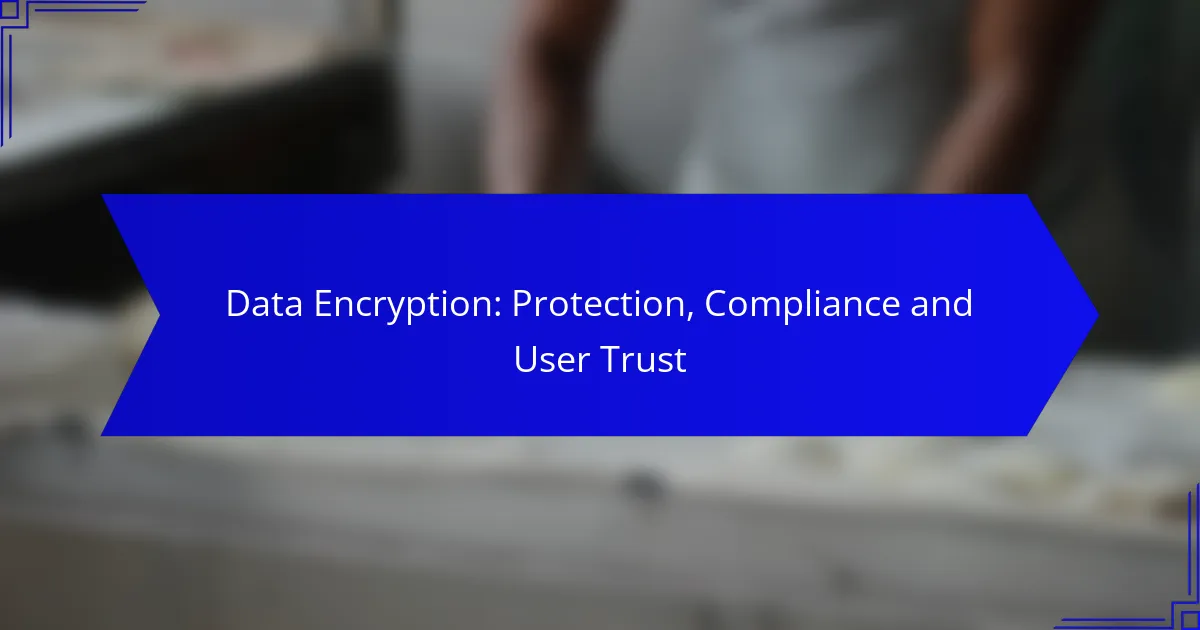Data encryption is essential for protecting sensitive information from unauthorized access, thereby enhancing user trust. By employing robust encryption methods, businesses can ensure compliance with regulations while fostering confidence among users who share personal details. Effective encryption not only safeguards data but also reinforces the integrity of the service or platform.

How does data encryption enhance user trust?
Data encryption enhances user trust by safeguarding sensitive information from unauthorized access. When users know their data is encrypted, they feel more secure sharing personal details, which builds confidence in the service or platform.
Increased data security
Data encryption significantly boosts data security by converting information into a coded format that can only be read by authorized parties. This process ensures that even if data is intercepted, it remains unintelligible without the proper decryption key.
Implementing strong encryption protocols, such as AES (Advanced Encryption Standard), can protect data both at rest and in transit. Regularly updating encryption methods helps maintain security against evolving threats.
Protection against breaches
Encryption acts as a critical line of defense against data breaches. In the event of a cyberattack, encrypted data is far less valuable to hackers, as they cannot easily access or exploit it without the decryption key.
Organizations should prioritize encrypting sensitive data, especially personal identifiable information (PII) and financial records. This proactive measure not only protects users but also mitigates potential financial losses and reputational damage from breaches.
Compliance with regulations
Many regulations, such as GDPR in Europe and HIPAA in the United States, mandate the protection of personal data through encryption. Compliance with these laws not only avoids hefty fines but also reinforces user trust by demonstrating a commitment to data protection.
Organizations should regularly review and update their encryption practices to ensure they meet current regulatory standards. This includes conducting audits and training staff on compliance requirements to maintain a secure environment for user data.
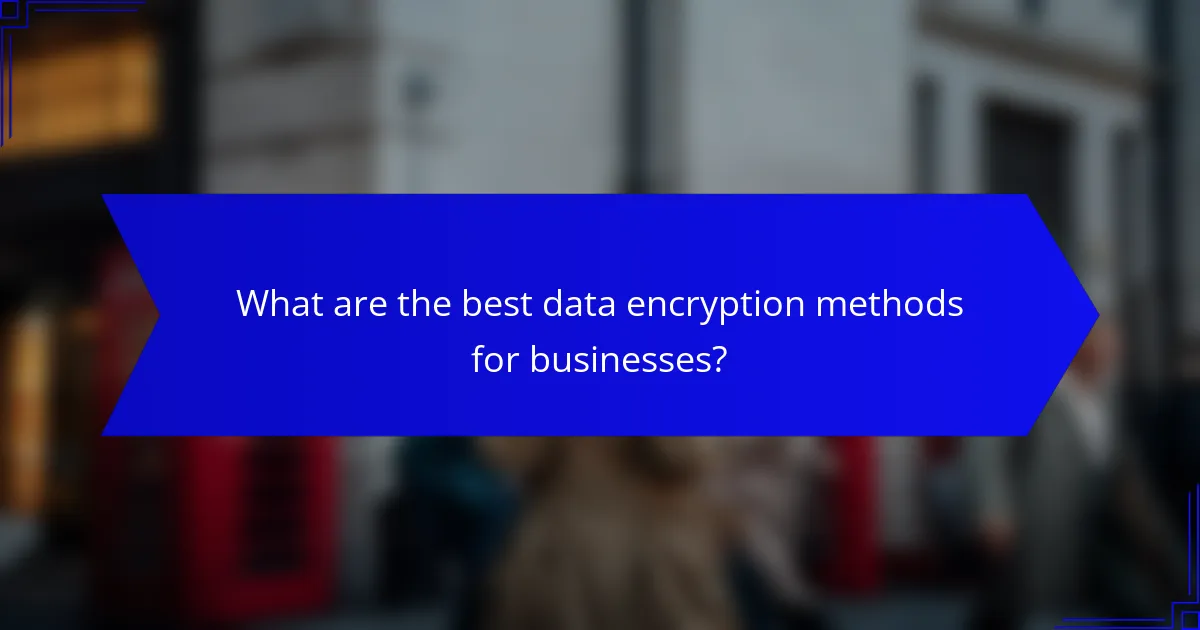
What are the best data encryption methods for businesses?
The best data encryption methods for businesses include AES, RSA, and SSL/TLS protocols. These techniques provide robust security for sensitive information, ensuring compliance with regulations and fostering user trust.
AES (Advanced Encryption Standard)
AES is a symmetric encryption algorithm widely used for securing data at rest. It operates on fixed block sizes and supports key lengths of 128, 192, or 256 bits, making it highly secure against brute-force attacks.
When implementing AES, businesses should consider the key management process, as the security of encrypted data relies heavily on the secrecy of the encryption keys. Regularly updating keys and using secure storage solutions are essential practices.
RSA (Rivest–Shamir–Adleman)
RSA is an asymmetric encryption method that uses a pair of keys: a public key for encryption and a private key for decryption. This approach is particularly useful for secure data transmission and digital signatures.
While RSA is effective, it is slower than symmetric methods like AES. Businesses should use RSA for key exchange and digital signatures, while relying on AES for encrypting larger data sets to balance security and performance.
SSL/TLS for data in transit
SSL (Secure Sockets Layer) and TLS (Transport Layer Security) protocols encrypt data transmitted over networks, protecting it from eavesdropping and tampering. These protocols are essential for securing online transactions and communications.
To implement SSL/TLS, businesses should obtain a valid SSL certificate from a trusted certificate authority and ensure that all web applications are configured to use HTTPS. Regularly updating certificates and monitoring for vulnerabilities are crucial for maintaining security.

How does data encryption ensure compliance?
Data encryption plays a crucial role in ensuring compliance with various regulations by protecting sensitive information from unauthorized access. By implementing strong encryption methods, organizations can meet legal requirements and enhance user trust in their data handling practices.
GDPR requirements
The General Data Protection Regulation (GDPR) mandates that organizations protect personal data through appropriate technical measures, including encryption. Encrypting data helps ensure that even if a data breach occurs, the information remains unreadable to unauthorized parties.
To comply with GDPR, businesses should assess their data processing activities and implement encryption for any personal data stored or transmitted. Regular audits and updates to encryption protocols are essential to maintain compliance and protect user privacy.
HIPAA standards
The Health Insurance Portability and Accountability Act (HIPAA) requires healthcare organizations to safeguard protected health information (PHI) through various security measures, including encryption. Encrypting PHI ensures that sensitive patient data is secure during storage and transmission, reducing the risk of breaches.
Healthcare providers must conduct risk assessments to determine where encryption is necessary and implement it accordingly. Regular training for staff on encryption practices and compliance requirements is also vital to uphold HIPAA standards.
PCI DSS adherence
The Payment Card Industry Data Security Standard (PCI DSS) outlines security measures for organizations that handle credit card information, including encryption. Encrypting cardholder data both in transit and at rest is a key requirement to protect against data theft and fraud.
To adhere to PCI DSS, businesses should implement strong encryption protocols and regularly test their systems for vulnerabilities. Maintaining compliance involves continuous monitoring and updating of encryption methods to address emerging threats and ensure the security of payment information.
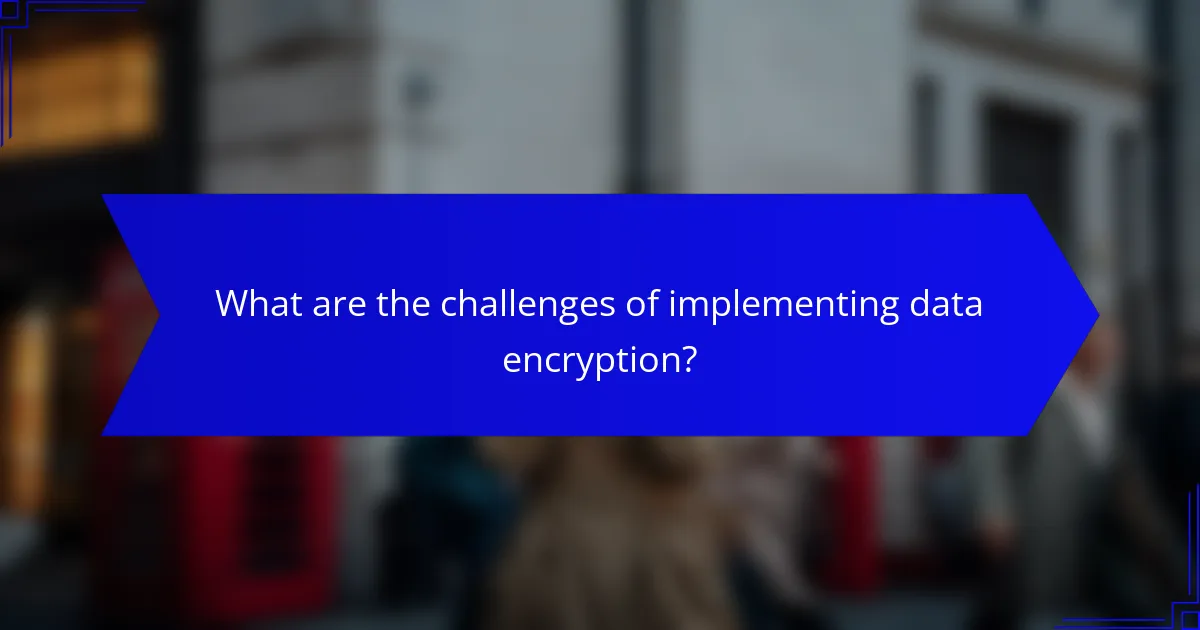
What are the challenges of implementing data encryption?
Implementing data encryption presents several challenges, including costs, integration complexity, and potential performance impacts. Organizations must navigate these hurdles to effectively secure sensitive information while maintaining operational efficiency.
Cost of encryption solutions
The cost of encryption solutions can vary significantly based on the technology and scale of implementation. Organizations may face initial expenses for software licenses, hardware upgrades, and ongoing maintenance costs, which can range from hundreds to thousands of dollars annually.
Additionally, there may be hidden costs related to training staff and ensuring compliance with regulations. Budgeting for encryption should consider both direct and indirect expenses to avoid unexpected financial burdens.
Complexity of integration
Integrating encryption into existing systems can be complex, requiring careful planning and execution. Organizations must assess their current infrastructure and determine how encryption will fit within their data workflows without disrupting operations.
Compatibility issues may arise, particularly with legacy systems, necessitating additional resources for troubleshooting and adjustments. A phased approach to integration can help mitigate risks and ensure a smoother transition.
Performance impact on systems
Data encryption can introduce latency and reduce system performance, particularly if not implemented efficiently. The extent of the performance impact often depends on the encryption method used and the volume of data being processed.
To minimize disruptions, organizations should conduct performance testing before full deployment and consider using hardware acceleration for encryption tasks. Regular monitoring can help identify and address any performance bottlenecks that may occur post-implementation.
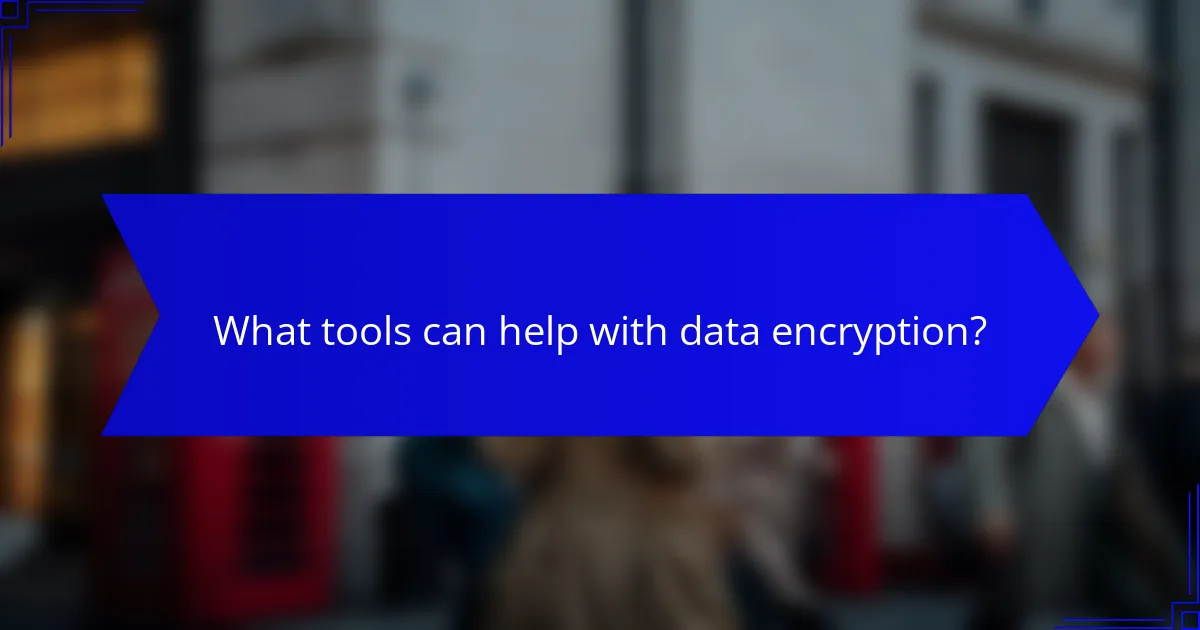
What tools can help with data encryption?
Several tools can assist with data encryption, each serving different purposes and environments. Choosing the right tool depends on your specific needs, whether for file protection, disk security, or secure communications.
VeraCrypt for file encryption
VeraCrypt is a popular open-source tool for encrypting files and folders. It allows users to create a virtual encrypted disk that can be mounted as a real disk, providing a straightforward way to secure sensitive data.
To use VeraCrypt effectively, install the software, create a new volume, and select the encryption algorithm that suits your needs. AES is commonly recommended for its balance of security and performance.
Be cautious with password complexity; a strong, unique password is crucial for safeguarding your encrypted files. Avoid using easily guessable passwords to enhance security.
BitLocker for disk encryption
BitLocker is a built-in encryption feature in Windows that protects entire disk drives. It encrypts the data on the drive, making it inaccessible without proper authentication, which can be a password or a smart card.
To enable BitLocker, access the Control Panel, select the drive you want to encrypt, and follow the prompts to set it up. It’s advisable to back up your recovery key in a secure location in case you forget your password.
BitLocker is particularly useful for businesses needing to comply with regulations like GDPR or HIPAA, as it helps protect sensitive information stored on devices.
OpenSSL for secure communications
OpenSSL is a widely used toolkit for implementing secure communications over networks. It provides robust encryption for data in transit, ensuring that sensitive information remains confidential during transmission.
To use OpenSSL, you can generate SSL/TLS certificates, encrypt files, or create secure connections between servers. Familiarize yourself with command-line operations to leverage its full capabilities effectively.
When implementing OpenSSL, ensure you keep your libraries updated to protect against vulnerabilities. Regularly review your configurations to maintain optimal security standards.
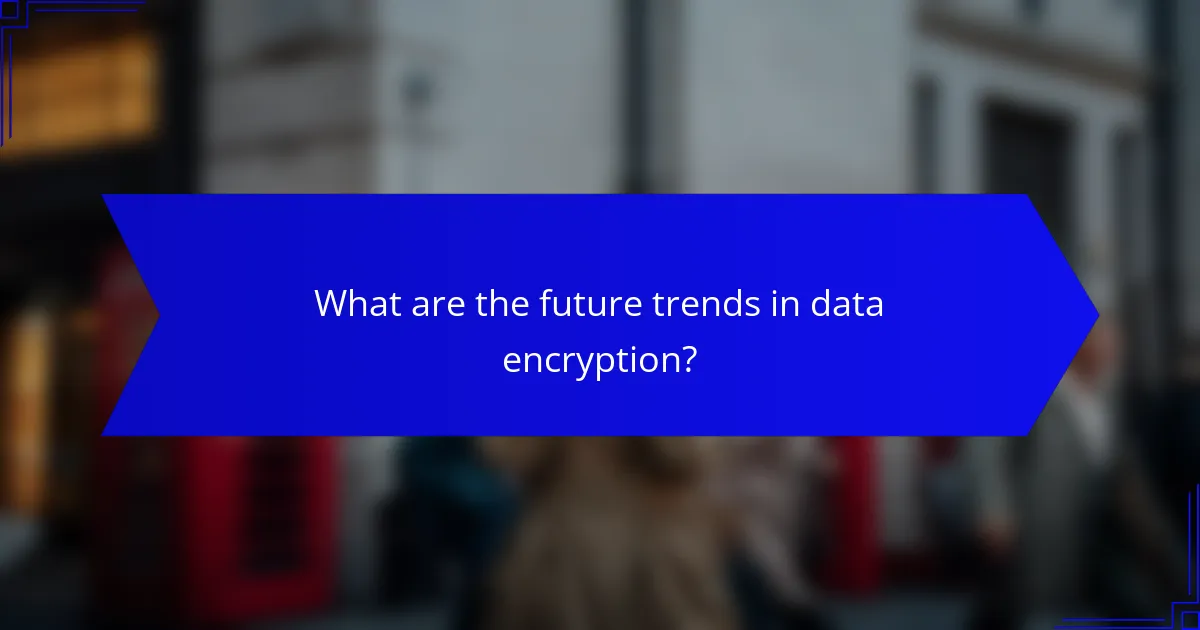
What are the future trends in data encryption?
Future trends in data encryption focus on enhancing security through innovative technologies like quantum encryption and AI-driven solutions. These advancements aim to address emerging threats and improve compliance with evolving regulations.
Quantum encryption advancements
Quantum encryption represents a significant leap in securing data by utilizing the principles of quantum mechanics. This technology allows for the creation of unbreakable encryption keys through quantum key distribution (QKD), which ensures that any attempt to intercept the key will be detected.
Organizations considering quantum encryption should evaluate its integration with existing systems and the potential need for specialized hardware. While still in development, early adopters may gain a competitive edge by enhancing their data security posture.
AI-driven encryption solutions
AI-driven encryption solutions leverage machine learning algorithms to adapt and respond to new threats in real-time. These systems can analyze patterns in data access and usage, enabling dynamic encryption strategies that adjust based on risk levels.
When implementing AI-driven encryption, organizations should focus on selecting solutions that offer scalability and compatibility with current infrastructure. Additionally, training staff to understand AI capabilities can enhance the effectiveness of these systems and reduce potential vulnerabilities.
